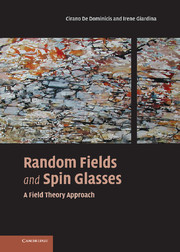Book contents
- Frontmatter
- Contents
- Preface
- List of abbreviations
- 1 A brief introduction
- 2 The Random Field Ising Model
- 3 The dynamical approach
- 4 The p = 2 spherical model
- 5 Mean field spin glasses: one-step RSB
- 6 The Sherrington–Kirkpatrick Model
- 7 Mean field via TAP equations
- 8 Spin glass above D = 6
- 9 Propagators, mostly replicon
- 10 Ward–Takahashi Identities and Goldstone modes
- 11 Alternative approaches and conclusions
- Appendix A Renormalization at one loop: ϕ4 theory (pure Ising)
- Appendix B Renormalization at one loop: tr ϕ3 theory (spin glass)
- Index
4 - The p = 2 spherical model
Published online by Cambridge University Press: 21 October 2009
- Frontmatter
- Contents
- Preface
- List of abbreviations
- 1 A brief introduction
- 2 The Random Field Ising Model
- 3 The dynamical approach
- 4 The p = 2 spherical model
- 5 Mean field spin glasses: one-step RSB
- 6 The Sherrington–Kirkpatrick Model
- 7 Mean field via TAP equations
- 8 Spin glass above D = 6
- 9 Propagators, mostly replicon
- 10 Ward–Takahashi Identities and Goldstone modes
- 11 Alternative approaches and conclusions
- Appendix A Renormalization at one loop: ϕ4 theory (pure Ising)
- Appendix B Renormalization at one loop: tr ϕ3 theory (spin glass)
- Index
Summary
In the previous chapters we have seen how the presence of disorder may be responsible for a novel behaviour at low temperature where bound states appear. In the case of the Random Field Ising Model we have been able to trace evidence of this nontrivial spin glass phase within a field theory, in both approaches from statics and dynamics. However, we did not go far enough to describe this phase and characterize its properties. In the rest of this book our aim will be precisely to address this problem, restricting ourselves to systems where it has been mostly studied in the last thirty years: spin glasses. For spin glasses, contrary to the RFIM, there is no random-site magnetic field; instead, the heterogeneity occurs in the exchange interactions between the spins that are then modelled as quenched random variables.
In this chapter we consider a first simple model of spin glass, the p = 2 spherical model, that is constrained to spins interacting by pairs. As usual, understanding is greatly helped if one is able to obtain an exact solution for a model that possesses some of the characteristic features of interest. This is the case of this spin model that, despite its coupling randomness, is exactly soluble, both for the statics and the dynamics, and does not require the replica method.
As we shall see, the p = 2 spherical model has not a true spin glass behaviour and is rather a disguised ferromagnet.
- Type
- Chapter
- Information
- Random Fields and Spin GlassesA Field Theory Approach, pp. 57 - 78Publisher: Cambridge University PressPrint publication year: 2006



